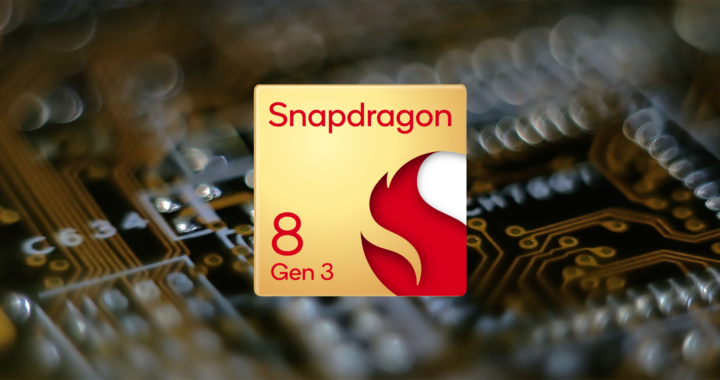Qualcomm announced its Snapdragon 8 Gen 3 on 24 October. This system-on-a-chip powers the flagship Android smartphones of 2024. It builds further on the earlier improvements seen in the first two generations of the Snapdragon 8 Series and banks on the growing practical applications of artificial intelligence on smartphones. This article reviews the pros and cons of the Snapdragon 8 Gen 3 by highlighting its key features and performance.
Key Features of Snapdragon 8 Gen 3
At the heart of the Snapdragon 8 Gen 3 is a set of new Kryo CPU cores and a newer Adreno GPU. The 8-core CPU includes 1 higher-performance Cortex-X4 core at 3.30 GHz, 3 overclocked performance Cortex A720 cores at 3.15 GHz and another 2 standard performance Cortex A720 cores at 2.96 GHz, and 2 power-efficient Cortex-A520 cores at 2.27 GHz.
Graphics processing is powered by the Adreno 750 integrated GPU. This GPU has native support for Vulkan 1.3, OpenGL ES 3.2, and OpenCL 2.0 FP graphics application programming interfaces. It can support screens at 240 Hz refresh rate and gameplay at 240 frames-per-second. There is also a built-in hardware-accelerated ray tracing support for Unreal Engine 5.2.
The chip also comes with coprocessors for accelerating AI tasks for on-device AI inference. These are the Qualcomm Hexagon NPU for handling larger AI models and the Sensing Hub for smaller AI models. The Hexagon component specifically works together with the Kryo CPU and Adreno GPU to implement the Qualcomm AI Engine and most AI-related features.
Another notable feature of the Snapdragon 8 Gen 3 is its wireless communication modules. The cellular radio is powered by the X75 5G Modem-RF System that supports both mmWave and sub-6 GHz 5G technologies with standalone and non-standalone modes, and mmWave-sub-6 dual mode. The FastConnect 7800 System includes Wi-Fi 7 and Bluetooth 5.4.
Qualcomm also takes pride in the audio technologies built into the chip. The Snapdragon Sound Technology Suite allows lossless audio over Wi-Fi via the Qualcomm XPAN Technology. It also supports 24-bit 96 kHz lossless music over Bluetooth. The suite also enables spatial audio with head tracking and ultra-low 48ms latency sound for a better gaming experience.
Performance of Snapdragon 8 Gen 3
1. General Processing Performance
The Snapdragon 8 Gen 3 provides flagship-level CPU performance for 2024. It scored 447352 in AnTuTu 10. This is about 13.28 percent higher than the 391644 score of Apple A17 Pro but about 7.97 percent lower than the 48477 score of MediaTek Dimensity 9300 under the same benchmark test. Note that these three chips power flagship smartphones for 2024.
Both single-core and multi-core test scores using GeekBench 6 show that it slightly fared less than the A17 Pro and Dimensity 9300. This Qualcomm chip scored 2193 in single-core test and 7304 in multi-core test. The A17 Pro scored 2953 and 7441 in single-core and multi-core tests while the Dimensity 930 scored 2239 and 7538 under the same CPU performance tests.
The differences in CPU scores between the Snapdragon 8 Gen 3 and other flagship chips of 2024 are not drastic. These are hardly noticeable in actual use-case scenarios. This chip demonstrates some slight improvements over the older 8 Gen 2. It is generally 14 percent faster and specifically 9.66 percent better in single-core and 31.82 percent in multi-core.
2. Graphics Processing Capabilities
It might not fare well against other flagship chips but one of the strengths of Snapdragon 8 Gen 3 is the graphics processing performance of its Adreno GPU. Result from AnTuTu 10 showed that it scored 904347 in GPU testing. This is 50.97 higher than the 53700 GPU score of Apple A17 Pro and 3.14 percent higher than the 876384 GPU score of MediaTek Dimensity 9300.
The score from 3DMark Wildlife Performance test that assessed graphics performance in Vulkan was 17276 at 103 frames per second. This is a noteworthy graphics performance score. It is 53.28 percent higher than the 10008 score of the A17 Pro at 59 frames per second and 43.08 higher than the 11068 score of Dimensity 9300 at 66 frames per second.
It also outperformed other flagship chips like the Tensor G3, which powers the Pixel 8 and Pixel 8 Pro, the Tensor G4, which powers the Pixel 9 and 9 Pro, and Samsung Exynos 2400, which powers international versions of the Samsung Galaxy S24 series, based on the GPU scores in AnTuTu 10. Tensor G3 scored 82.35 percent lower at 376816 while Samsung Exynos 2400 scored 22.32 percent lower at 722765.
3. Artificial Intelligence Acceleration
The implementation of AI acceleration in Snapdragon chips differs from how companies like Apple or Google integrate AI accelerators in their chip designs. The Qualcomm Engine constitutes the Qualcomm Hexagon NPU, the Kryo CPU, and the Adreno GPU, as well as the Sensing Hub. The Hexagon is the AI component with its scalar, vector, and tensor accelerators.
Nonetheless, based on the data from Qualcomm, the Hexagon of Snapdragon 8 Gen 3 delivers 98 percent faster performance and 40 percent improved performance-power-watt in sustained AI inferencing than the previous 8 Gen 2. The entire AI Engine can run large language models with up to 20 tokens per second while the specific Sensing Hub handles smaller models.
The Snapdragon 8 Gen 3 might not fare well compared to the Apple A17 Pro chip and the Google Tensor G3 chip in terms of parallel computing while handling AI workloads. Apple has a dedicated and standalone Neural Engine and Google has integrated a dedicated Tensor Processing Unit in its chip design to offload most AI-related tasks from the CPUs and GPUs.
